Abstract
The incidence of breast cancer in the United States has steadily increased for the past three decades. Exposure to excess estrogen, in both natural and synthetic forms, has been implicated as a risk factor for the development of this disease. Considerable interest has been focused on organochlorines, such as the triazine herbicides, and their possible role in the initiation or promotion of human breast cancer. To explore this relationship, an ecologic study of Kentucky counties was designed. Exposure to triazines was estimated by use of water contamination data, corn crop production, and pesticide use data. A summary index of triazine herbicide exposure was developed to classify counties into low, medium, or high exposure levels. Data on county breast cancer rates were obtained from the state registry. A Poisson regression analysis was performed, controlling for age, race, age at first live birth, income, and level of education. Results revealed a statistically significant increase in breast cancer risk with medium and high levels of triazine exposure [odds ratio (OR) = 1.14,p<0.0001 and OR = 1.2, p<0.0001, respectively]. The results suggest a relationship between exposure to triazine herbicides and increased breast cancer risk, but conclusions concerning causality cannot be drawn, due to the limitations inherent in ecologic study design.
Full text
PDF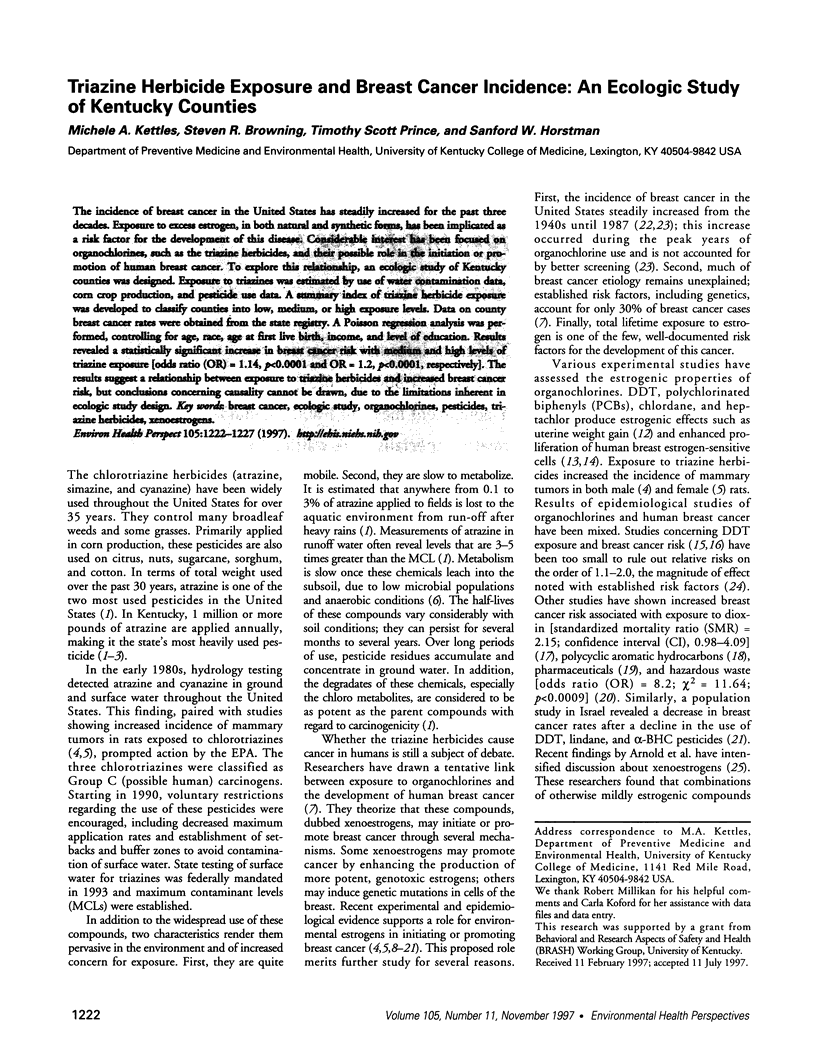
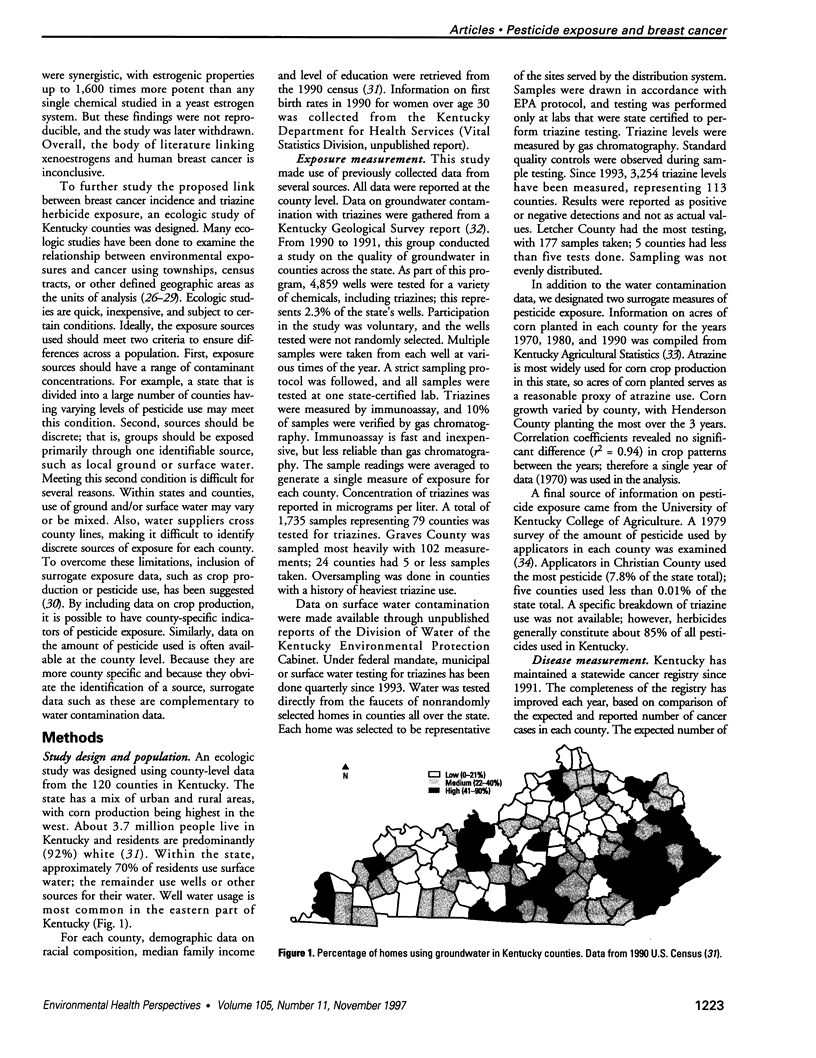
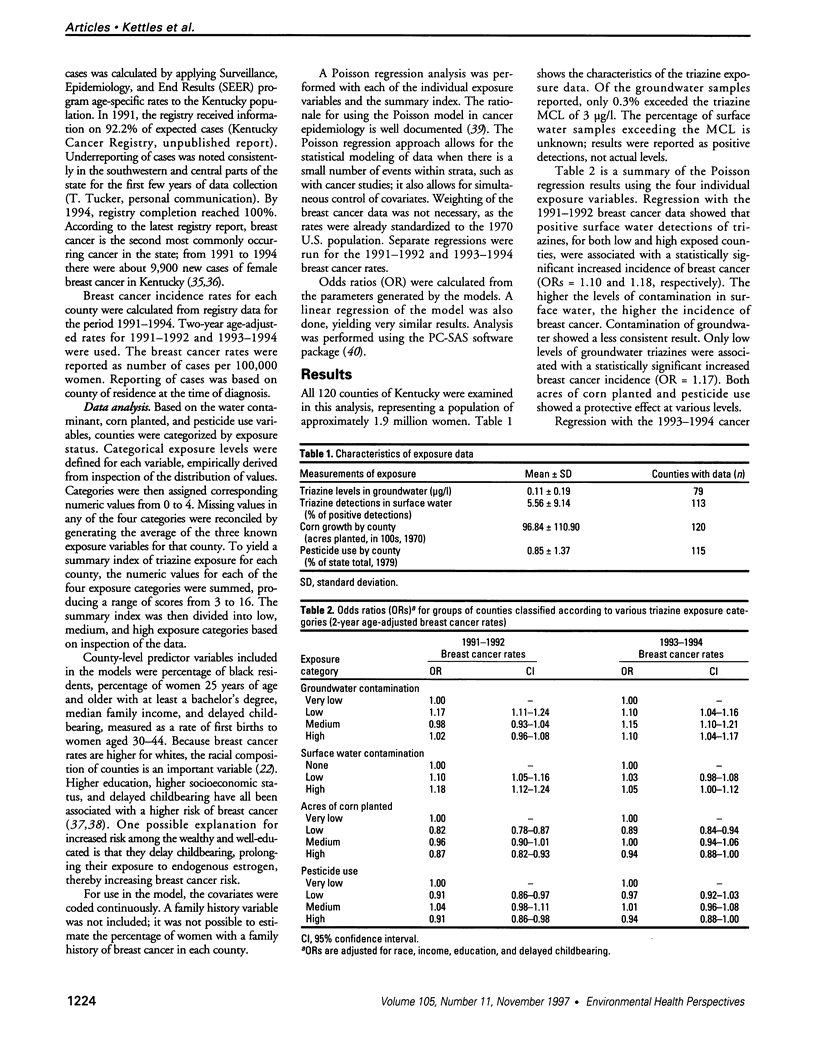
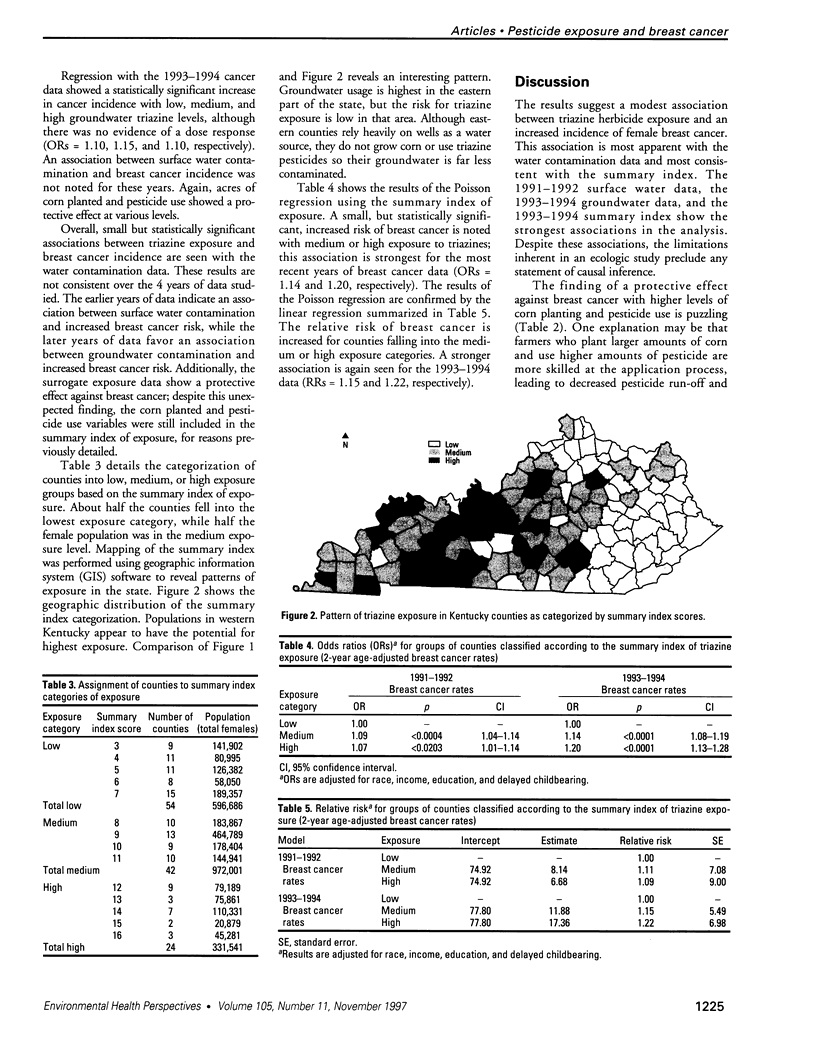
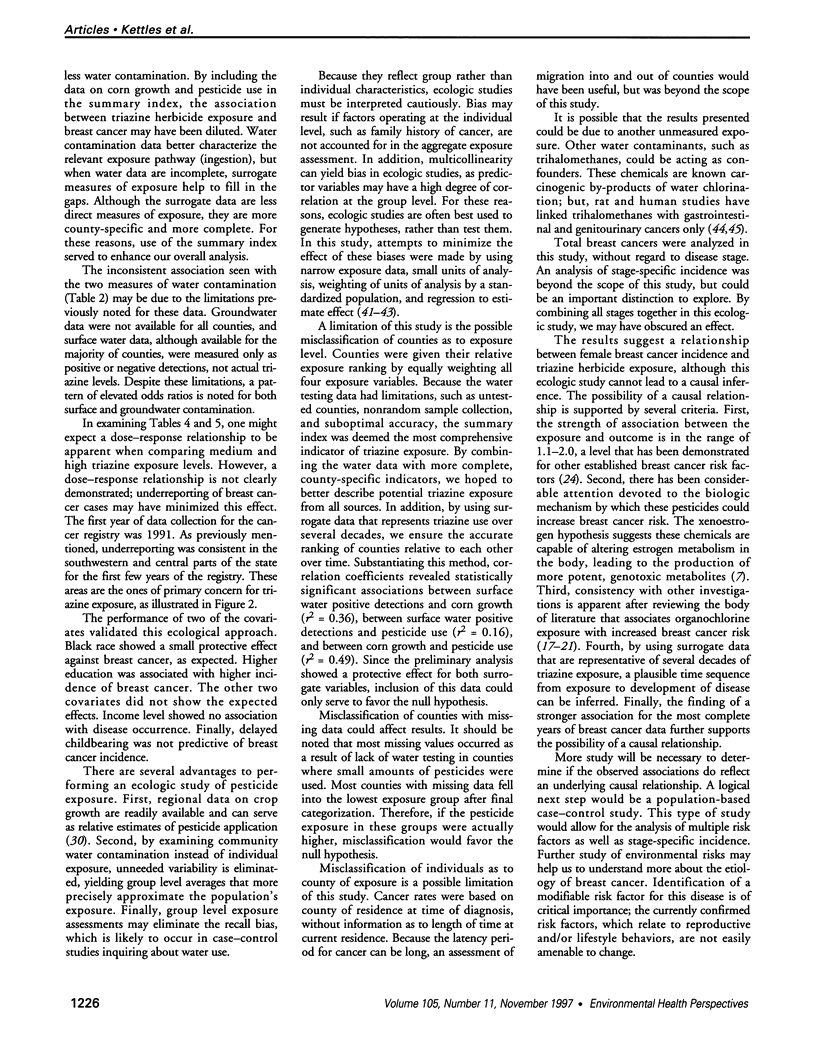
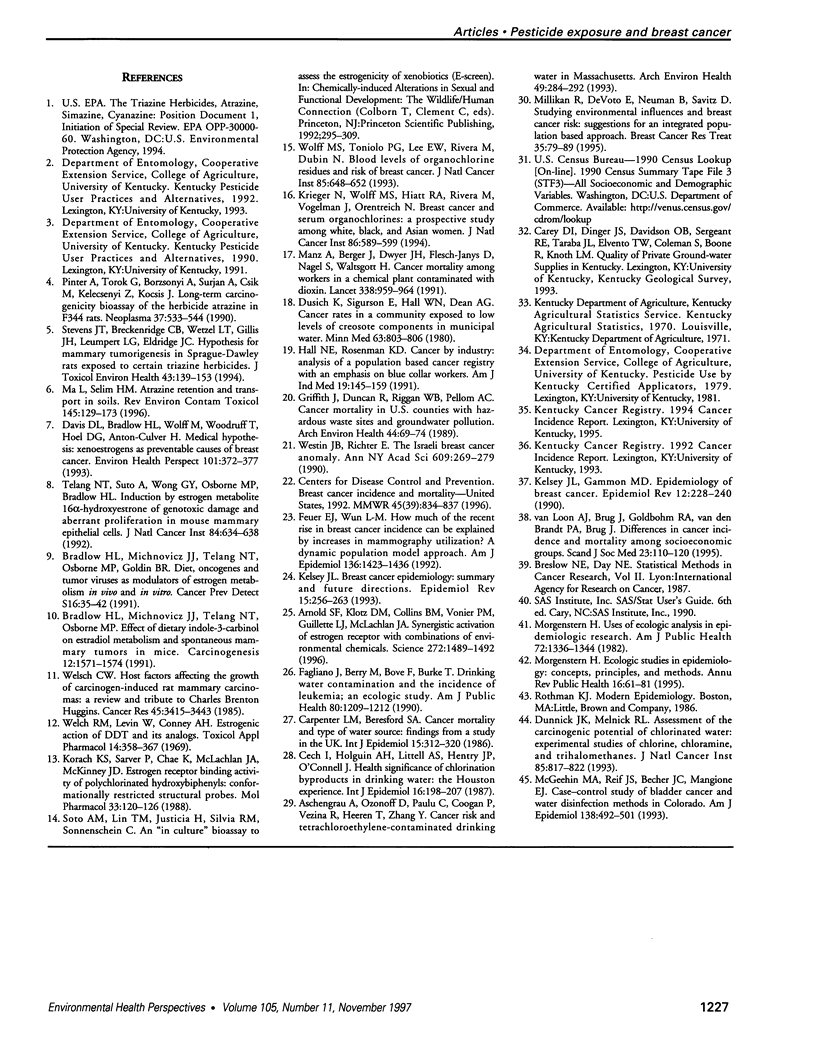
Images in this article
Selected References
These references are in PubMed. This may not be the complete list of references from this article.
- Arnold S. F., Klotz D. M., Collins B. M., Vonier P. M., Guillette L. J., Jr, McLachlan J. A. Synergistic activation of estrogen receptor with combinations of environmental chemicals. Science. 1996 Jun 7;272(5267):1489–1492. doi: 10.1126/science.272.5267.1489. [DOI] [PubMed] [Google Scholar]
- Aschengrau A., Ozonoff D., Paulu C., Coogan P., Vezina R., Heeren T., Zhang Y. Cancer risk and tetrachloroethylene-contaminated drinking water in Massachusetts. Arch Environ Health. 1993 Sep-Oct;48(5):284–292. doi: 10.1080/00039896.1993.9936715. [DOI] [PubMed] [Google Scholar]
- Bradlow H. L., Michnovicz J., Telang N. T., Osborne M. P. Effects of dietary indole-3-carbinol on estradiol metabolism and spontaneous mammary tumors in mice. Carcinogenesis. 1991 Sep;12(9):1571–1574. doi: 10.1093/carcin/12.9.1571. [DOI] [PubMed] [Google Scholar]
- Carpenter L. M., Beresford S. A. Cancer mortality and type of water source: findings from a study in the UK. Int J Epidemiol. 1986 Sep;15(3):312–320. doi: 10.1093/ije/15.3.312. [DOI] [PubMed] [Google Scholar]
- Cech I., Holguin A. H., Littell A. S., Henry J. P., O'Connell J. Health significance of chlorination byproducts in drinking water: the Houston experience. Int J Epidemiol. 1987 Jun;16(2):198–207. doi: 10.1093/ije/16.2.198. [DOI] [PubMed] [Google Scholar]
- Davis D. L., Bradlow H. L., Wolff M., Woodruff T., Hoel D. G., Anton-Culver H. Medical hypothesis: xenoestrogens as preventable causes of breast cancer. Environ Health Perspect. 1993 Oct;101(5):372–377. doi: 10.1289/ehp.93101372. [DOI] [PMC free article] [PubMed] [Google Scholar]
- Dunnick J. K., Melnick R. L. Assessment of the carcinogenic potential of chlorinated water: experimental studies of chlorine, chloramine, and trihalomethanes. J Natl Cancer Inst. 1993 May 19;85(10):817–822. doi: 10.1093/jnci/85.10.817. [DOI] [PubMed] [Google Scholar]
- Dusich K., Sigurdson E., Hall W. N., Dean A. G. Cancer rates in a community exposed to low levels of creosote components in municipal water. Minn Med. 1980 Nov;63(11):803–806. [PubMed] [Google Scholar]
- Fagliano J., Berry M., Bove F., Burke T. Drinking water contamination and the incidence of leukemia: an ecologic study. Am J Public Health. 1990 Oct;80(10):1209–1212. doi: 10.2105/ajph.80.10.1209. [DOI] [PMC free article] [PubMed] [Google Scholar]
- Feuer E. J., Wun L. M. How much of the recent rise in breast cancer incidence can be explained by increases in mammography utilization? A dynamic population model approach. Am J Epidemiol. 1992 Dec 15;136(12):1423–1436. doi: 10.1093/oxfordjournals.aje.a116463. [DOI] [PubMed] [Google Scholar]
- Griffith J., Duncan R. C., Riggan W. B., Pellom A. C. Cancer mortality in U.S. counties with hazardous waste sites and ground water pollution. Arch Environ Health. 1989 Mar-Apr;44(2):69–74. doi: 10.1080/00039896.1989.9934378. [DOI] [PubMed] [Google Scholar]
- Hall N. E., Rosenman K. D. Cancer by industry: analysis of a population-based cancer registry with an emphasis on blue-collar workers. Am J Ind Med. 1991;19(2):145–159. doi: 10.1002/ajim.4700190203. [DOI] [PubMed] [Google Scholar]
- Kelsey J. L. Breast cancer epidemiology: summary and future directions. Epidemiol Rev. 1993;15(1):256–263. doi: 10.1093/oxfordjournals.epirev.a036112. [DOI] [PubMed] [Google Scholar]
- Kelsey J. L., Gammon M. D. Epidemiology of breast cancer. Epidemiol Rev. 1990;12:228–240. doi: 10.1093/oxfordjournals.epirev.a036056. [DOI] [PubMed] [Google Scholar]
- Korach K. S., Sarver P., Chae K., McLachlan J. A., McKinney J. D. Estrogen receptor-binding activity of polychlorinated hydroxybiphenyls: conformationally restricted structural probes. Mol Pharmacol. 1988 Jan;33(1):120–126. [PubMed] [Google Scholar]
- Krieger N., Wolff M. S., Hiatt R. A., Rivera M., Vogelman J., Orentreich N. Breast cancer and serum organochlorines: a prospective study among white, black, and Asian women. J Natl Cancer Inst. 1994 Apr 20;86(8):589–599. doi: 10.1093/jnci/86.8.589. [DOI] [PubMed] [Google Scholar]
- Ma L., Selim H. M. Atrazine retention and transport in soils. Rev Environ Contam Toxicol. 1996;145:129–173. doi: 10.1007/978-1-4612-2354-2_2. [DOI] [PubMed] [Google Scholar]
- Manz A., Berger J., Dwyer J. H., Flesch-Janys D., Nagel S., Waltsgott H. Cancer mortality among workers in chemical plant contaminated with dioxin. Lancet. 1991 Oct 19;338(8773):959–964. doi: 10.1016/0140-6736(91)91835-i. [DOI] [PubMed] [Google Scholar]
- McGeehin M. A., Reif J. S., Becher J. C., Mangione E. J. Case-control study of bladder cancer and water disinfection methods in Colorado. Am J Epidemiol. 1993 Oct 1;138(7):492–501. doi: 10.1093/oxfordjournals.aje.a116883. [DOI] [PubMed] [Google Scholar]
- Millikan R., DeVoto E., Newman B., Savitz D. Studying environmental influences and breast cancer risk: suggestions for an integrated population-based approach. Breast Cancer Res Treat. 1995 Jul;35(1):79–89. doi: 10.1007/BF00694748. [DOI] [PubMed] [Google Scholar]
- Morgenstern H. Ecologic studies in epidemiology: concepts, principles, and methods. Annu Rev Public Health. 1995;16:61–81. doi: 10.1146/annurev.pu.16.050195.000425. [DOI] [PubMed] [Google Scholar]
- Morgenstern H. Uses of ecologic analysis in epidemiologic research. Am J Public Health. 1982 Dec;72(12):1336–1344. doi: 10.2105/ajph.72.12.1336. [DOI] [PMC free article] [PubMed] [Google Scholar]
- Pintér A., Török G., Börzsönyi M., Surján A., Csík M., Kelecsényi Z., Kocsis Z. Long-term carcinogenicity bioassay of the herbicide atrazine in F344 rats. Neoplasma. 1990;37(5):533–544. [PubMed] [Google Scholar]
- Stevens J. T., Breckenridge C. B., Wetzel L. T., Gillis J. H., Luempert L. G., 3rd, Eldridge J. C. Hypothesis for mammary tumorigenesis in Sprague-Dawley rats exposed to certain triazine herbicides. J Toxicol Environ Health. 1994 Oct;43(2):139–153. doi: 10.1080/15287399409531911. [DOI] [PubMed] [Google Scholar]
- Telang N. T., Suto A., Wong G. Y., Osborne M. P., Bradlow H. L. Induction by estrogen metabolite 16 alpha-hydroxyestrone of genotoxic damage and aberrant proliferation in mouse mammary epithelial cells. J Natl Cancer Inst. 1992 Apr 15;84(8):634–638. doi: 10.1093/jnci/84.8.634. [DOI] [PubMed] [Google Scholar]
- Welch R. M., Levin W., Conney A. H. Estrogenic action of DDT and its analogs. Toxicol Appl Pharmacol. 1969 Mar;14(2):358–367. doi: 10.1016/0041-008x(69)90117-3. [DOI] [PubMed] [Google Scholar]
- Welsch C. W. Host factors affecting the growth of carcinogen-induced rat mammary carcinomas: a review and tribute to Charles Brenton Huggins. Cancer Res. 1985 Aug;45(8):3415–3443. [PubMed] [Google Scholar]
- Westin J. B., Richter E. The Israeli breast-cancer anomaly. Ann N Y Acad Sci. 1990;609:269–279. doi: 10.1111/j.1749-6632.1990.tb32074.x. [DOI] [PubMed] [Google Scholar]
- Wolff M. S., Toniolo P. G., Lee E. W., Rivera M., Dubin N. Blood levels of organochlorine residues and risk of breast cancer. J Natl Cancer Inst. 1993 Apr 21;85(8):648–652. doi: 10.1093/jnci/85.8.648. [DOI] [PubMed] [Google Scholar]
- van Loon A. J., Brug J., Goldbohm R. A., van den Brandt P. A., Burg J [corrected to Brug J. ]. Differences in cancer incidence and mortality among socio-economic groups. Scand J Soc Med. 1995 Jun;23(2):110–120. doi: 10.1177/140349489502300206. [DOI] [PubMed] [Google Scholar]




